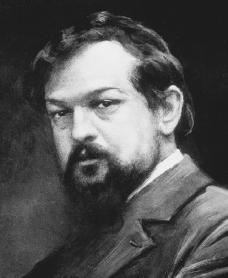Claude Debussy Biography
Born: August 22, 1862
St-Germain-en-Laye, France
Died: March 25, 1918
Paris, France
French composer
The French composer (writer and arranger of music) Claude Debussy developed a strongly individual style and went against the methods of classical composing by using uncommon arrangements that created a new language of sound.
Early life
Achille Claude Debussy was born on August 22, 1862, in St-Germain-en-Laye, France. He was the oldest of five children. His father, Manuel-Achille Debussy, ran a china shop and had a hard time making ends meet. Debussy began taking piano lessons at age seven and entered the Paris Conservatory (school of fine arts) in Paris, France, at the age of ten. His instructors and fellow students recognized that he had talent, but they thought some of his attempts to create new sounds were odd. In 1880 Nadezhda von Meck, who had helped support Russian composer Peter Ilich Tchaikovsky (1840–1893),

Reproduced by permission of
Different musical influences
In 1884 Debussy won the Prix de Rome, a competition for composers, for his cantata (a poem set to music) The Prodigal Son. While in Rome, Italy, the following year, he wrote that one of the few things that made him forget how much he missed Paris was the study of German composer Richard Wagner's (1813–1883) opera Tristan und Isolde. (Debussy returned to Paris in 1887.) Not many years later Debussy strongly criticized Wagner, but this had more to do with Wagner's drama than his music. Although Debussy scorned the characters in Wagner's Parsifal, he openly praised the music. Throughout his life Debussy was fascinated by the richness of Wagner's style, although he generally preferred opera that was less flashy.
Debussy was also strongly affected by the Javanese gamelan, which he saw performed at the Paris World Exposition of 1889. This orchestra, with its variety of bells, gongs, and xylophones (instruments made up of a series of wooden bars that sound different notes when struck with two small hammers), produced a series of soft effects and rhythms that Debussy loved. The years between 1890 and 1900 brought the elements of the gamelan into play with others already present in Debussy's style and produced a new kind of sound. The completion of this process around 1900 can serve as a line dividing the masterpieces of the earlier years— Ariettes oubliées (1888), Prélude à l'après-midi d'un faune (1892; Afternoon of a Faun ), and the String Quartet (1893)—from those composed during Debussy's mature period.
Mature period
Debussy's first large-scale piece of his mature period, the Nocturnes for orchestra (1893–99), was produced while he was working on his only completed opera, Pelléas et Mélisande (1894–1902), based on a play by Maurice Maeterlinck (1862–1949). The publicity surrounding the first performance of Pelléas in 1902 made Debussy the most controversial (causing disputes) musical figure in France; people either loved his music or hated it. Pelléas is the key work of Debussy's creative life; the words and actions of the opera pass as if in a dream, but the dream is filled with a strong feeling of dread. Debussy adds to this feeling with music that is largely quiet, with outbursts thrown in that reveal the underlying terror.
In 1904 Debussy left his wife of five years, Rosalie Texier, to live with Emma Bardac, a woman who had a decent amount of money and whom he would eventually marry. Debussy became more productive after he no longer had to worry about how he was going to earn money. During these years he wrote some of his most lasting works: La Mer (1905) and Ibéria (1908), both for orchestra; Images (1905), Children's Corner Suite (1908), and two books of Préludes (1910–12), all for piano solo.
Later years
Debussy's pieces of the following years show certain changes in style. They have less immediate appeal and are more difficult to approach. The emergence of other composers also led to declining interest in his works. His ballet Jeux, his last and most complicated orchestral score, first performed on May 15, 1913, was all but forgotten after Igor Stravinsky's (1882–1971) ballet Rite of Spring came out on May 29. Debussy may have resented the younger composer's arrival on the scene, but he admired Stravinsky's work and even used certain Stravinsky-like elements in En blanc et noir (1915) and the Études (1915).
When Debussy composed these works, he was already suffering from terminal cancer. He completed only three of a planned group of six pieces "for various instruments" (1915–17) before dying in Paris on March 25, 1918.
For More Information
Dietschy, Marcel. A Portrait of Claude Debussy. New York: Oxford University Press, 1990.
Lockspeiser, Edward. Debussy: His Life and Mind. 2 vols. London: Cassell, 1962. Reprint, New York: Cambridge University Press, 1978.
Nichols, Roger. Debussy Remembered. Portland, OR: Amadeus Press, 1992.
Nichols, Roger. The Life of Debussy. New York: Cambridge University Press, 1998.
I also believe that he loved someone and got married and then he tried to get her todo suicide so he could marry someone else. He had a daughter i don't remeber what her name was though.